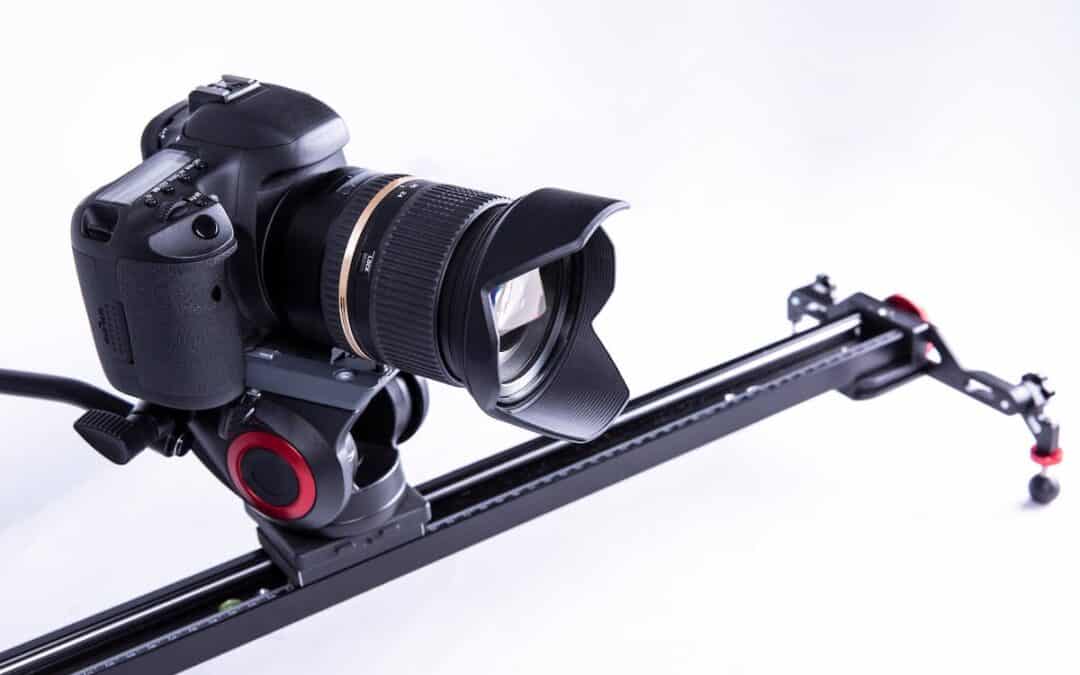Camera sliders aren’t necessary to use for filming interviews, but they can certainly make the process much easier. You might be wondering which camera sider is best to pull this off.
The overall best camera slider for interviews is the GVM Motorized Camera Slider (available on Amazon.com). This slider can shoot in different modes including horizontal, tracking, and 120° degrees. It also has a timelapse function, a silent motor, adjustable legs, and a handy controller.
The only instances where we wouldn’t recommend this product is if:
- You need a budget-friendly option. If this is the case, go for the Neewer Aluminum Alloy Camera Track (available on Amazon.com).
- You want a small slider that’s best suited to your phone. Choose the Rhino Camera Gear ROV PRO (available on Amazon.com).
- You want a slider with extra length. Go for the innovative Edelkrone SliderPLUS v5 PRO Long (available on Amazon.com).
The best quality sliders will help you capture highly professional, cinematic movement. And thanks to the ubiquity of DSLR cameras and smartphones, there’s a massive range of sliders out on the market these days. Read on to discover why we’ve chosen the above sliders for you to consider.
Table of Contents
Filming an Interview With a Camera Slider
If you aim to record an interview with a smaller camera and want to increase the footage’s production value, you should definitely invest in a high-quality slider. Incorporating a bit of slow, subtle movement into the shots will enhance the quality of an otherwise static and rather mundane interview.
But as you want to capture your interviewee and interviewer with precise, small, smooth movements, it’s great to opt for a slider rather than hand holding the camera. Camera sliders are a fantastic means to achieve a dolly or tracking effect with seamless, cinematic movement.
This video on YouTube shows how a slider looks in action while capturing an interview.
Different Types of Camera Sliders
There’s a vast range of camera sliders to consider. They come with varying features and plenty of pros and cons, depending on what you’re aiming for.
Sliders can differ in the following aspects:
- Length. Shorter sliders have limited movement potential, but longer ones can be a pain to set up. When filming an interview, however, you won’t need a huge range of movement.
- Weight. A slider’s weight will depend on its length, size, and the material from which it’s made.
- Material. Sliders made from carbon fiber will be lighter, but they won’t be sturdy enough to hold as much weight as ones made from steel. Generally, camera sliders are either steel, aluminum, or carbon fiber products.
- Weight of the camera that it can hold. When selecting a slider, keep in mind the weight of your camera and how strong you need your slider to be.
- Price. There’s a considerable price difference between the very cheapest and most expensive ones out there. The cheapest sliders start at around $40, while the priciest can be $800 or more.
- Lens options. One of the advantages of sliders over gimbals (and gimbal stabilizers) is that the former offers you flexibility with lenses.
- Feet. Most smaller sliders will have feet, meaning you won’t necessarily need to bring along a tripod (or two). Some feet are designed for flat surfaces, while others will allow for gripping onto uneven surfaces.
- Crank belts. According to Omnicore, many of the higher-end camera sliders on the market allow you to attach crank belts or other attachments. These products help you move your camera along while remaining in the same position.
Keep the above features in mind when deciding on which slider is the best choice for you and the interview you want to film.
Best Overall: GVM Motorized Camera Slider, 31” – GR80QD
The GR80QD from GVM (Great Video Makers) is a fantastic slider choice for your interview. This slider has all the best features that you want at a fraction of the cost of competitors’ comparable products.
Made from carbon fiber, the slider is only 10 lbs and can hold up to 20 lbs. Its eight layers of carbon fiber ensure that this product is strong, stable, and smooth while being light enough for comfortable transportation.
It features three distinct shooting modes: horizontal mode, tracking mode, and 120° pan mode. It’s unusual to find a slider at this price point that allows you to achieve such a wide degree of panning.
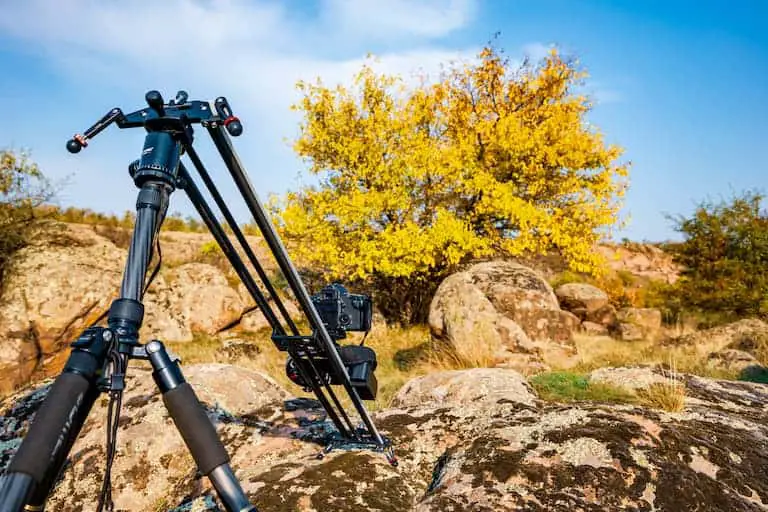
You’ll find that the slider comes fully assembled and with its own travel case in the box. The GVM GR80QD also comes with adjustable feet and can easily be attached to a tripod. It also has multiple screw ports.
It has a controller with an LED screen that allows you to set the distance ranges and speed you want to film at. When filming an interview, you probably will be going for a relatively slow speed and possibly won’t require the entire 32” (81 centimeters) of slider length.
The slider’s controller gives you great flexibility, ease of operation, and repeatability. This YouTube video explains why cheap doesn’t necessarily mean low-quality:
This quality slider comes with a controller that has both a manual and an auto mode. In manual mode, once you’ve released the button, the slider ramps down to a smooth stop (rather than jerking suddenly to a halt).
It’s nice, thoughtful touches like these that really add up to make the GR80QD such a great choice.
Furthermore, if you’re shooting an interview, you will want to ensure your slider has a quiet motor so as not to interfere with the voices you’re recording. Thankfully, the GVM GR80QD slider has a silent motor, which will make your editing process a lot easier.
One of the most unique and appealing features of this slider—and unusual for its price point—is its adjustable middle rod. This middle bar controls the rotation of the center caddy, meaning that by adjusting the rack, your camera will track a subject.
In addition, by changing the position of this middle bar, you can achieve a 120° pan. The GVM GR80QD offers the best qualities you’ll want to create seamless, effortless dolly and tracking shots. And you won’t need to break the bank to get the effect you’re aiming for.
The video below by DOD Media is a demonstration and tutorial of the handy features of this versatile yet affordable slider.
Best for Budget: Neewer Aluminum Alloy Camera Track Slider Video Stabilizer Rail
Measuring 23.6 inches (60 centimeters) in length, this track slider from Neewer is the best budget-friendly choice. It’s an even more cost-effective alternative, should you be seeking an excellent quality slider at a very reasonable price.
And unlike the GVM slider discussed above, this Neewer product is made from aluminum alloy. It can support a camera weighing up to 17.5 lbs (8 kilograms).
It allows for horizontal, vertical, and angled shooting. This slider features adjustable legs that make it easy to secure the positioning of the slider. And it also comes with a bag to efficiently store and transport this item.
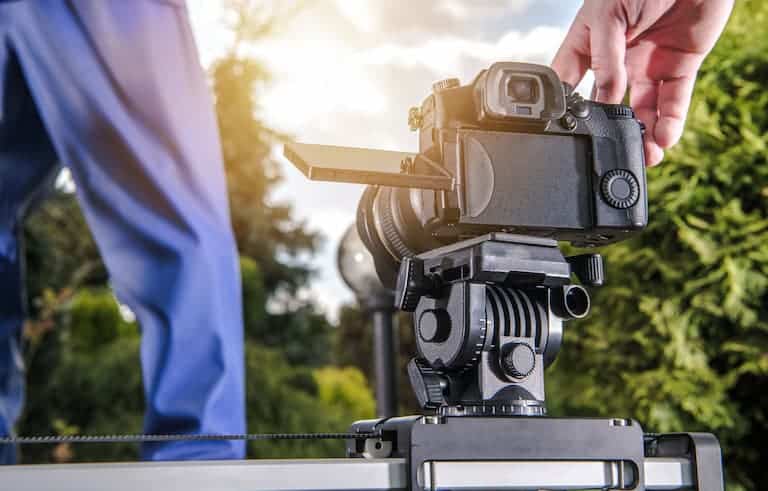
Best Small Slider for Phones: Rhino Camera Gear ROV PRO Everyday Motorized Slider
This small slider is pricier than the Neewer one mentioned above, but it is worth the money if you seek the very best slider for your smartphone. This ultra-compact, motorized slider is excellent for both your phone and DSLR cameras.
The ROV PRO weighs just 4.2 lbs (1.95 kilograms), which is a super-light option. Measuring in at just 8 inches long (20 centimeters), this slider from Rhino is a fantastic choice for those looking for a super-light and small slider with excellent portability.
You needn’t opt for the bulkiest and most enormous slider to get the seamless movements and smooth effects you’re after. Small sliders such as the ROV PRO are of excellent quality while being easy to transport, set up, and use.
Furthermore, the Rhino Camera Gear ROB PRO Slider comes with a very convenient app. This slider seamlessly pairs with your smartphone, meaning that you can fully control its movement from your phone.
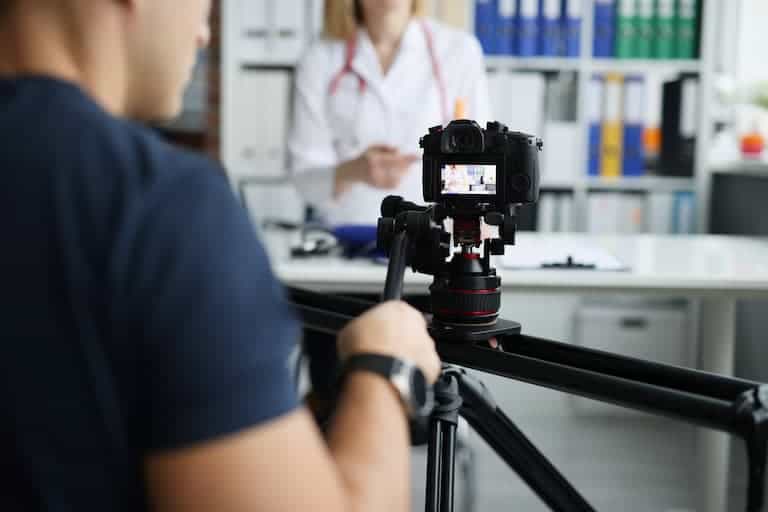
Best for Extra Length: Edelkrone SliderPLUS v5 PRO Long
For some filmmakers shooting interviews, they don’t necessarily need a long slider. But if you do prefer a slider with extra length, the SliderPLUS v5 PRO Long could be a great choice for you.
Its innovative, award-winning design allows you to combine both portability with the range you need. The slider achieves this by featuring rails that slide along with the camera, allowing you to reach double the length of standard, stationary rails.
Compared with regular sliders, the Edelkrone SliderPLUS will help you reach up to double the dolly in/out range. And because the rail moves along with the camera, you won’t have to worry about accidentally capturing the slider in your footage!
The Edelkrone SliderPLUS range is super easy to set up and start using right away. The sliders have a locking mechanism which makes them easy to relocate. And they also feature built-in, foldable legs (also with locking mechanisms).
The v5 version of the Edelkrone SliderPLUS also allows you to do impressive inclines of up to 22.5°. This range also comes with an app that will enable you to control all your devices through one interface.
If you don’t require the entire length of the v5 PRO Long, the SliderPLUS is also available in a smaller, compact size, which also comes with the innovative features of the more extended size.
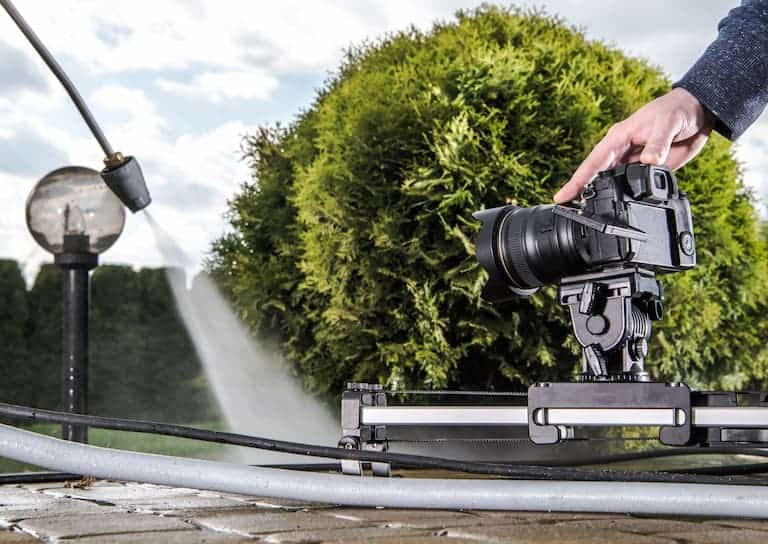
Camera Slider vs. Camera Dolly vs. Gimbal
How exactly does a camera slider differ from a dolly? You may hear these equipment terms used interchangeably, and they function in similar ways. They’re both support equipment that allows you to move your camera to capture smooth, moving shots.
Generally, the term “camera dolly” refers to the bulky, expensive, and complex devices that involve a wheeled cart (or similar) that runs along tracks on a platform.
These huge devices are more often associated with professional directors and require a camera crew to help operate them. But you might hear smaller sliders (designed for smaller cameras) referred to as dollys, as they both aim to achieve the same effect.
Like sliders, dolly shots allow filmmakers to move their cameras horizontally or vertically alongside (or towards or away from) their subject.
The dolly shot technique can add a lot of depth and layers to your filmmaking and increase the audience’s engagement with a scene. Adding some subtle, slow movement into your interview footage can engage the audience and lend your shots a cinematic flair.
Gimbals
Gimbals could be said to rival sliders and dolly shots. You can also purchase stabilizers for gimbals, should you want to use them for capturing your interview. However, one of the most significant advantages of sliders is that they are more flexible in terms of lenses.
The YouTube video below gives you a run-down on the pros and cons of both sliders and gimbals:
Key Takeaways
The overall best camera slider for interviews is the GVM GR80-QD for its quiet motor, handy controller, and impressive panning range.
Other great options include:
- Best for Budget: Neewer Aluminum Alloy Camera Track Slider.
- Best Small Slider for Phones: Rhino Camera Gear ROV PRO.
- Best for Extra Length: Edelkrone SliderPLUS v5 PRO Long.
Sliders allow you to engage your audience and add depth to your footage. Many amateurs and professionals alike are turning to camera sliders to give a cinematic touch to their filmmaking, and with the right slider, you can certainly take your craft to the next level.

